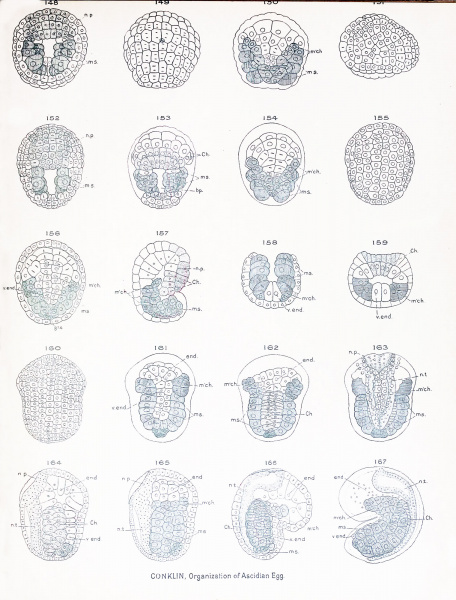File:Conklin 1905 plate10.jpg

Original file (1,521 × 2,000 pixels, file size: 606 KB, MIME type: image/jpeg)
Plate X - Entire Embryos of Cynthia partita - Gastrula to Tadpole
Muscle cells shaded by vertical lines, mesenchyme by transverse line*, nerve plate and tube by fine stipples, chorda by coarse stipples.
Figs. 148-151. Four view? of the same embryo; fig. 14.8 dorsal, 149 ventral -posterior, 150 same view but deeper level, showing mesoderm and endoderm, 151 right side. Many of the ectoderm cells are passing into the 10th generation.
Figs. 152-154. Three views of : embryo ; fig. 152 dorsal, showing closure of the blastopore from in front, 153 same view but deeper level, showing cells beneath the ectoderm, 154 ventral view of mesoderm and endoderm below ectoderm.
Figs. 155 and 156. Two ventral views of an advanced gastrula, the first showing the superficial ectoderm, the latter the endoderm and mesoderm lying beneath the ectoderm.
Fig. 157. Left side of embryo, showing, in optical section, muscle cells, mesenchyme, chorda and nerve plate.
Figs. 158 and 159. Two optical sections of the same embryo, the former (158) through the open blastopore at the posterior end of the embryo, the latter (159) through the region anterior to the blastopore.
Figs. 160-162. Three views of the same embryo from the ventral side but drawn at different levels; 160 surface view showing ectoderm ; 161 same view deeper level, showing mesoderm and endoderm : 162 same view still deeper level, showing chorda, mesoderm and endoderm.
Fig. 163. Dorsal view of embryo of same stage as preceding showing nerve plate and tube, mesoderm and chorda.
Figs. 164 and 165. Two views of same embryo from right side ; fig. 164 median optical section showing chorda, nerve tube and endoderm ; 165 more superficial view showing muscle cells and mesenchyme.
Fig. 166. Older embryo from right side, showing in optical section nerve tube, chorda, mesoderm and endoderm.
Fig. 167. Young tadpole from left side showing in optical section nerve tube, chorda and mesoderm.
| Historic Disclaimer - information about historic embryology pages |
|---|
| Pages where the terms "Historic" (textbooks, papers, people, recommendations) appear on this site, and sections within pages where this disclaimer appears, indicate that the content and scientific understanding are specific to the time of publication. This means that while some scientific descriptions are still accurate, the terminology and interpretation of the developmental mechanisms reflect the understanding at the time of original publication and those of the preceding periods, these terms, interpretations and recommendations may not reflect our current scientific understanding. (More? Embryology History | Historic Embryology Papers) |
- Conklin Figures: Fig 1-2 | Fig 3-6 | Fig 7-8 | Fig 9-12 | Fig 13-16 | Fig 17-20 | Fig 21-24 | Fig 25-26 | Fig 27-33 | Fig 34-35 | Plate I | Plate II | Plate III | Plate IV | Plate V | Plate VI | Plate VII | Plate VIII | Plate IX | Plate X | Plate XI | Plate XII
Reference
Conklin EG. The Organization and Cell-Lineage of the Ascidian Egg (1905) J. Acad., Nat. Sci. Phila. 13, 1.
Conklin 1905 TOC: I. The Ovarian Egg | II. Maturation and Fertilization | III. Orientation of Egg and Embryo | IV. Cell-Lineage | V. Later Development | VI. Comparisons with A.mphioxus and Amphibia | VII. The Organization of the Egg | Summary | Literature Cited | Explanation of Figures
Cite this page: Hill, M.A. (2024, April 20) Embryology Conklin 1905 plate10.jpg. Retrieved from https://embryology.med.unsw.edu.au/embryology/index.php/File:Conklin_1905_plate10.jpg
- © Dr Mark Hill 2024, UNSW Embryology ISBN: 978 0 7334 2609 4 - UNSW CRICOS Provider Code No. 00098G
File history
Click on a date/time to view the file as it appeared at that time.
| Date/Time | Thumbnail | Dimensions | User | Comment | |
|---|---|---|---|---|---|
| current | 16:33, 19 October 2016 |  | 1,521 × 2,000 (606 KB) | Z8600021 (talk | contribs) |
You cannot overwrite this file.
File usage
The following 2 pages use this file:
